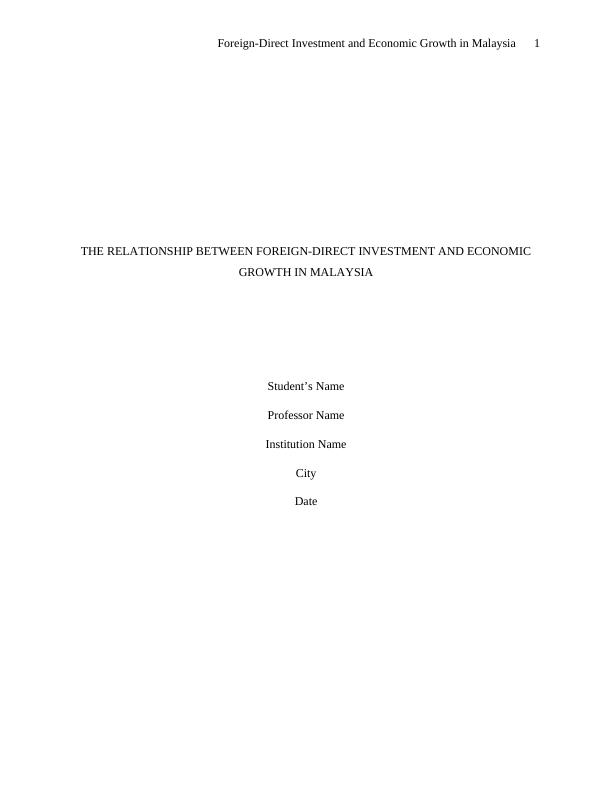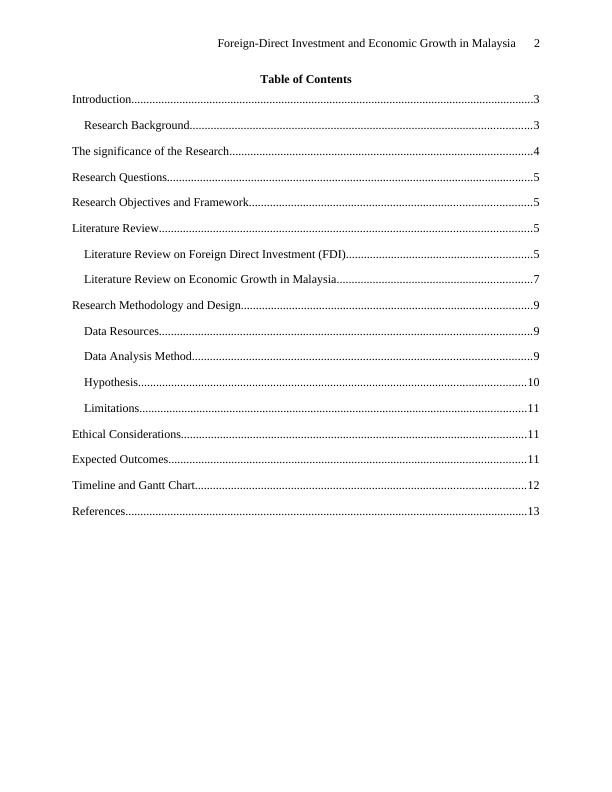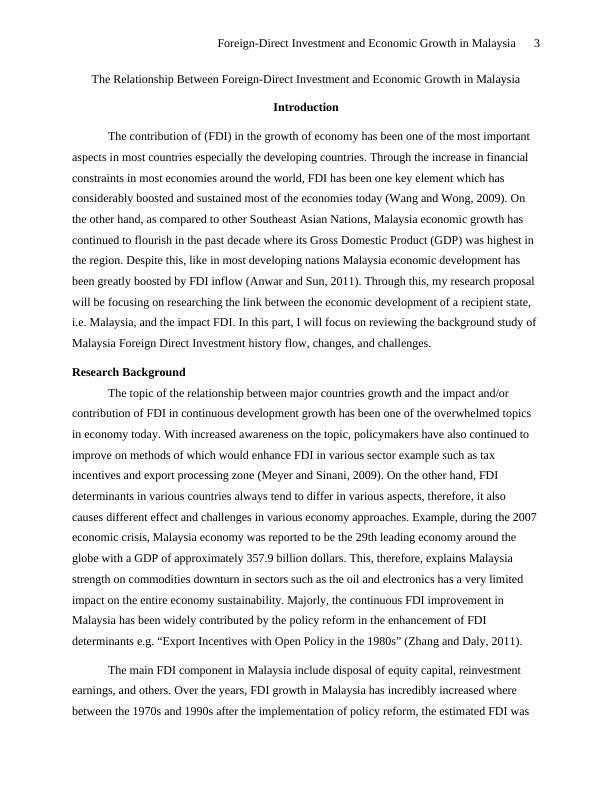Foreign-Direct Investment and Economic Growth in Malaysia
Added on 2023-06-04
15 Pages4776 Words174 Views
Foreign-Direct Investment and Economic Growth in Malaysia 1
THE RELATIONSHIP BETWEEN FOREIGN-DIRECT INVESTMENT AND ECONOMIC
GROWTH IN MALAYSIA
Student’s Name
Professor Name
Institution Name
City
Date
THE RELATIONSHIP BETWEEN FOREIGN-DIRECT INVESTMENT AND ECONOMIC
GROWTH IN MALAYSIA
Student’s Name
Professor Name
Institution Name
City
Date

Foreign-Direct Investment and Economic Growth in Malaysia 2
Table of Contents
Introduction......................................................................................................................................3
Research Background..................................................................................................................3
The significance of the Research.....................................................................................................4
Research Questions..........................................................................................................................5
Research Objectives and Framework..............................................................................................5
Literature Review............................................................................................................................5
Literature Review on Foreign Direct Investment (FDI)..............................................................5
Literature Review on Economic Growth in Malaysia.................................................................7
Research Methodology and Design.................................................................................................9
Data Resources............................................................................................................................9
Data Analysis Method.................................................................................................................9
Hypothesis.................................................................................................................................10
Limitations.................................................................................................................................11
Ethical Considerations...................................................................................................................11
Expected Outcomes.......................................................................................................................11
Timeline and Gantt Chart..............................................................................................................12
References......................................................................................................................................13
Table of Contents
Introduction......................................................................................................................................3
Research Background..................................................................................................................3
The significance of the Research.....................................................................................................4
Research Questions..........................................................................................................................5
Research Objectives and Framework..............................................................................................5
Literature Review............................................................................................................................5
Literature Review on Foreign Direct Investment (FDI)..............................................................5
Literature Review on Economic Growth in Malaysia.................................................................7
Research Methodology and Design.................................................................................................9
Data Resources............................................................................................................................9
Data Analysis Method.................................................................................................................9
Hypothesis.................................................................................................................................10
Limitations.................................................................................................................................11
Ethical Considerations...................................................................................................................11
Expected Outcomes.......................................................................................................................11
Timeline and Gantt Chart..............................................................................................................12
References......................................................................................................................................13

Foreign-Direct Investment and Economic Growth in Malaysia 3
The Relationship Between Foreign-Direct Investment and Economic Growth in Malaysia
Introduction
The contribution of (FDI) in the growth of economy has been one of the most important
aspects in most countries especially the developing countries. Through the increase in financial
constraints in most economies around the world, FDI has been one key element which has
considerably boosted and sustained most of the economies today (Wang and Wong, 2009). On
the other hand, as compared to other Southeast Asian Nations, Malaysia economic growth has
continued to flourish in the past decade where its Gross Domestic Product (GDP) was highest in
the region. Despite this, like in most developing nations Malaysia economic development has
been greatly boosted by FDI inflow (Anwar and Sun, 2011). Through this, my research proposal
will be focusing on researching the link between the economic development of a recipient state,
i.e. Malaysia, and the impact FDI. In this part, I will focus on reviewing the background study of
Malaysia Foreign Direct Investment history flow, changes, and challenges.
Research Background
The topic of the relationship between major countries growth and the impact and/or
contribution of FDI in continuous development growth has been one of the overwhelmed topics
in economy today. With increased awareness on the topic, policymakers have also continued to
improve on methods of which would enhance FDI in various sector example such as tax
incentives and export processing zone (Meyer and Sinani, 2009). On the other hand, FDI
determinants in various countries always tend to differ in various aspects, therefore, it also
causes different effect and challenges in various economy approaches. Example, during the 2007
economic crisis, Malaysia economy was reported to be the 29th leading economy around the
globe with a GDP of approximately 357.9 billion dollars. This, therefore, explains Malaysia
strength on commodities downturn in sectors such as the oil and electronics has a very limited
impact on the entire economy sustainability. Majorly, the continuous FDI improvement in
Malaysia has been widely contributed by the policy reform in the enhancement of FDI
determinants e.g. “Export Incentives with Open Policy in the 1980s” (Zhang and Daly, 2011).
The main FDI component in Malaysia include disposal of equity capital, reinvestment
earnings, and others. Over the years, FDI growth in Malaysia has incredibly increased where
between the 1970s and 1990s after the implementation of policy reform, the estimated FDI was
The Relationship Between Foreign-Direct Investment and Economic Growth in Malaysia
Introduction
The contribution of (FDI) in the growth of economy has been one of the most important
aspects in most countries especially the developing countries. Through the increase in financial
constraints in most economies around the world, FDI has been one key element which has
considerably boosted and sustained most of the economies today (Wang and Wong, 2009). On
the other hand, as compared to other Southeast Asian Nations, Malaysia economic growth has
continued to flourish in the past decade where its Gross Domestic Product (GDP) was highest in
the region. Despite this, like in most developing nations Malaysia economic development has
been greatly boosted by FDI inflow (Anwar and Sun, 2011). Through this, my research proposal
will be focusing on researching the link between the economic development of a recipient state,
i.e. Malaysia, and the impact FDI. In this part, I will focus on reviewing the background study of
Malaysia Foreign Direct Investment history flow, changes, and challenges.
Research Background
The topic of the relationship between major countries growth and the impact and/or
contribution of FDI in continuous development growth has been one of the overwhelmed topics
in economy today. With increased awareness on the topic, policymakers have also continued to
improve on methods of which would enhance FDI in various sector example such as tax
incentives and export processing zone (Meyer and Sinani, 2009). On the other hand, FDI
determinants in various countries always tend to differ in various aspects, therefore, it also
causes different effect and challenges in various economy approaches. Example, during the 2007
economic crisis, Malaysia economy was reported to be the 29th leading economy around the
globe with a GDP of approximately 357.9 billion dollars. This, therefore, explains Malaysia
strength on commodities downturn in sectors such as the oil and electronics has a very limited
impact on the entire economy sustainability. Majorly, the continuous FDI improvement in
Malaysia has been widely contributed by the policy reform in the enhancement of FDI
determinants e.g. “Export Incentives with Open Policy in the 1980s” (Zhang and Daly, 2011).
The main FDI component in Malaysia include disposal of equity capital, reinvestment
earnings, and others. Over the years, FDI growth in Malaysia has incredibly increased where
between the 1970s and 1990s after the implementation of policy reform, the estimated FDI was

Foreign-Direct Investment and Economic Growth in Malaysia 4
about 94 billion dollars in total. However, during the 1990s, there was a fluctuation in the FDI
rate after the significant decrease of Taiwan and Japanese investors in the country. Also in the
2007 financial crisis, the FDI percentage was significantly affected by most of the blame focused
on the government inability to attract and sustain investors in the economy (Jensen, 2008).
Through the continuous increase in competition in the region, Malaysia has lost a considerable
large number of investors to neighboring countries such as India and China who provide more
interesting offers like the availability of cheap and ready labor. In the past decade, the FDI has
not been performing well where currently in the second quarter of 2018 it has reduced MYR
11.98 billion to MYR 2.84 billion.
Fig 1: Malaysia Foreign Direct Investment history (Jensen, 2008)
The significance of the Research
Today, FDI is considered one of the vital elements towards the aspect of continuous
modernization in industrialization and the improvement of economy in most nations. The FDI
has been characterized to contribute a lot to the economic sector in areas such as employment
creation and enhanced remuneration, foreign exchange earnings, and improvement in industry
skills. Countries such as China and India are some of the major nations which have significantly
utilized FDI as the main source of economy and society development (Alfaro and Johnson,
2012). The research analysis will, therefore, concentrate on reviewing and understanding
about 94 billion dollars in total. However, during the 1990s, there was a fluctuation in the FDI
rate after the significant decrease of Taiwan and Japanese investors in the country. Also in the
2007 financial crisis, the FDI percentage was significantly affected by most of the blame focused
on the government inability to attract and sustain investors in the economy (Jensen, 2008).
Through the continuous increase in competition in the region, Malaysia has lost a considerable
large number of investors to neighboring countries such as India and China who provide more
interesting offers like the availability of cheap and ready labor. In the past decade, the FDI has
not been performing well where currently in the second quarter of 2018 it has reduced MYR
11.98 billion to MYR 2.84 billion.
Fig 1: Malaysia Foreign Direct Investment history (Jensen, 2008)
The significance of the Research
Today, FDI is considered one of the vital elements towards the aspect of continuous
modernization in industrialization and the improvement of economy in most nations. The FDI
has been characterized to contribute a lot to the economic sector in areas such as employment
creation and enhanced remuneration, foreign exchange earnings, and improvement in industry
skills. Countries such as China and India are some of the major nations which have significantly
utilized FDI as the main source of economy and society development (Alfaro and Johnson,
2012). The research analysis will, therefore, concentrate on reviewing and understanding

End of preview
Want to access all the pages? Upload your documents or become a member.
Related Documents
Factors Affecting Economic Growth in Malaysialg...
|12
|3091
|56
International trade Assignment PDFlg...
|15
|843
|77
Relationship between Foreign Direct Investment and GDP growth of Vietnamlg...
|13
|3478
|24
FDI Impacts on the Chinese Economylg...
|21
|4379
|430
FDIs and Country Attractiveness in Vietnam - UNCTADlg...
|6
|1387
|274
China’s Economic Growth Assignment PDFlg...
|4
|886
|107
